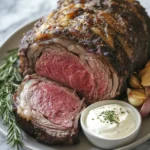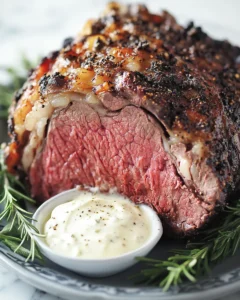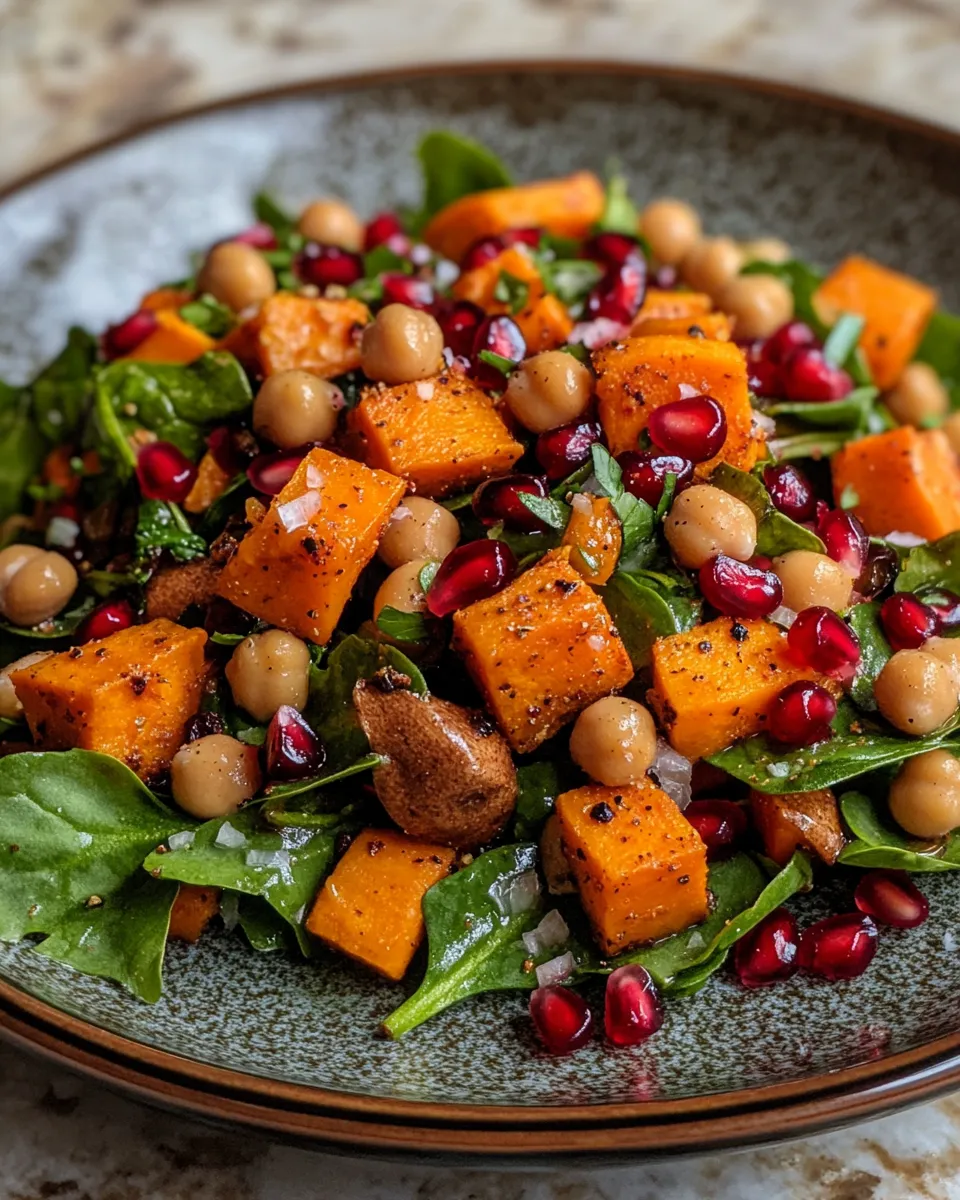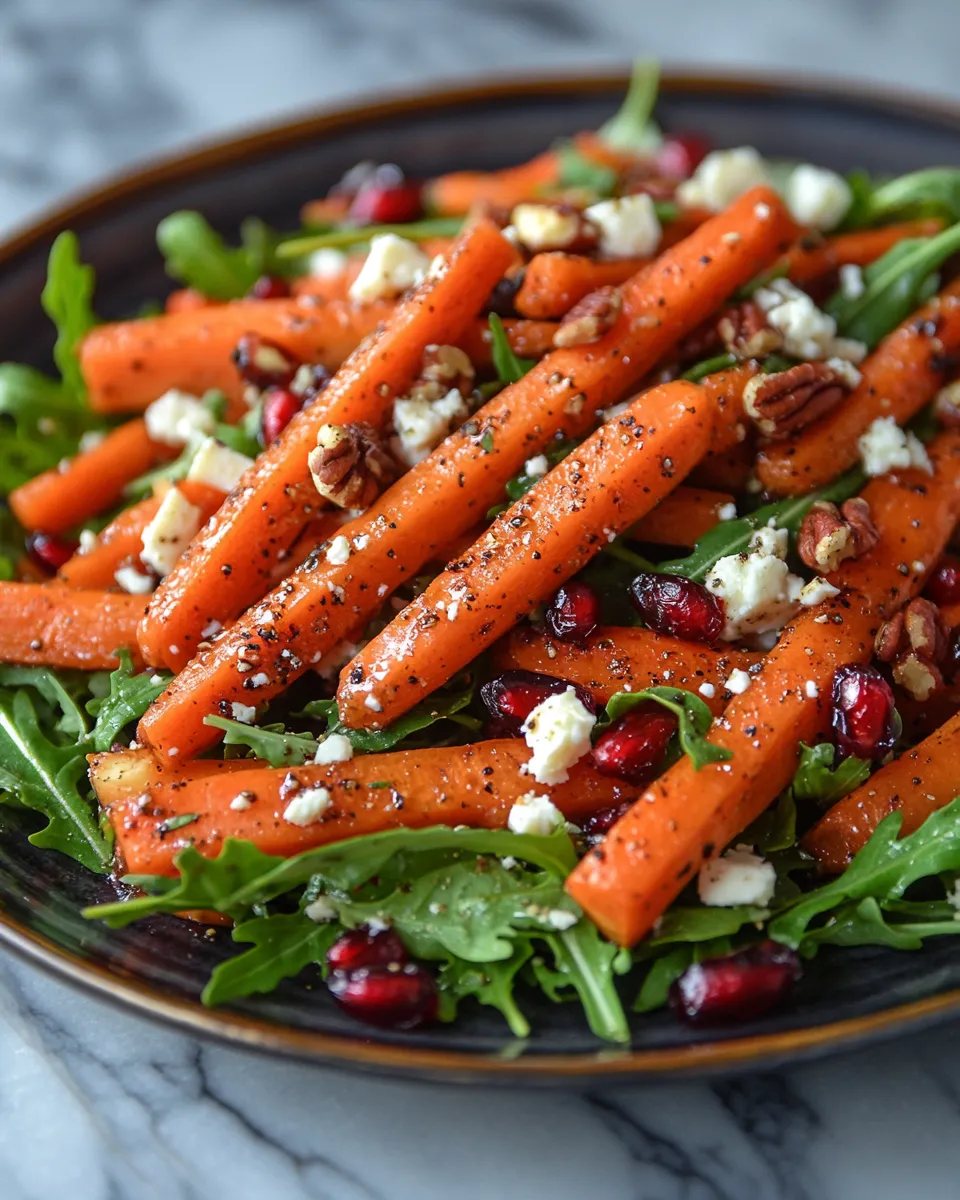There are few dishes that can turn an ordinary dinner into a celebration quite like a perfectly slow-roasted prime rib. Tender, juicy, and bursting with rich beef flavor, this show-stopping centerpiece makes any gathering feel special. Whether it’s a cozy family dinner, a festive holiday feast, or a weekend indulgence, this recipe guarantees a memorable meal that everyone will talk about long after the plates are cleared.
This version of Slow-Roasted Prime Rib with Creamy Horseradish Sauce draws inspiration from traditional steakhouse classics, where the secret lies in patience and precision. By roasting low and slow, the beef retains its natural juices and develops that melt-in-your-mouth tenderness. Paired with a homemade creamy horseradish sauce that’s tangy, smooth, and slightly spicy, every bite is a perfect harmony of flavor. It’s not just a dish—it’s an experience, one that makes the whole house smell amazing as it cooks.
Ingredients
For the Prime Rib
-
1 (6 to 8-pound) prime rib roast, bone-in (also called a standing rib roast)
-
3 tablespoons olive oil
-
4 teaspoons kosher salt
-
2 teaspoons freshly ground black pepper
-
2 teaspoons garlic powder
-
2 teaspoons onion powder
-
2 teaspoons dried thyme
-
2 teaspoons dried rosemary
-
1 teaspoon paprika
-
6 cloves garlic, minced
-
1 medium onion, roughly chopped
-
Fresh rosemary sprigs (optional, for garnish)
For the Creamy Horseradish Sauce
-
1 cup sour cream
-
3 tablespoons prepared horseradish (adjust to taste)
-
1 tablespoon Dijon mustard
-
1 teaspoon lemon juice
-
1 teaspoon Worcestershire sauce
-
1/2 teaspoon garlic powder
-
Salt and black pepper, to taste
Directions
1. Prepare the Prime Rib
Remove the prime rib from the refrigerator and let it sit at room temperature for about 2 hours before cooking. This step is essential because it allows the roast to cook more evenly. If the meat is too cold, the outer layer will overcook before the center reaches the desired temperature.
Meanwhile, preheat your oven to 450°F (232°C). Line a large roasting pan with foil for easy cleanup and set a roasting rack inside.
2. Season the Meat
In a small bowl, combine olive oil, salt, pepper, garlic powder, onion powder, thyme, rosemary, paprika, and minced garlic. Mix until you have a thick, aromatic paste.
Pat the roast dry with paper towels, then rub the seasoning mixture all over the surface of the beef. Make sure to coat every side thoroughly for maximum flavor. Place the roast on the rack, fat side up, so the juices naturally baste the meat as it cooks. Scatter the chopped onions around the base of the pan for added aroma.
3. Sear at High Heat
Place the roast in the preheated oven and sear for 20 minutes. This high-heat blast creates a flavorful crust on the outside of the meat, sealing in all the savory juices.
After 20 minutes, reduce the oven temperature to 325°F (163°C) without opening the oven door.
4. Slow Roast to Perfection
Continue roasting until the internal temperature reaches your desired doneness:
-
120°F (49°C) for rare
-
130°F (54°C) for medium-rare
-
140°F (60°C) for medium
Use an instant-read meat thermometer inserted into the thickest part of the roast to check. This step ensures accuracy and helps you avoid overcooking.
For an average 6 to 8-pound roast, this process typically takes 2½ to 3½ hours, depending on your oven and the size of the cut.
5. Let It Rest
Once the prime rib reaches the target temperature, remove it from the oven and tent it loosely with aluminum foil. Let it rest for 20–30 minutes before slicing. This resting period allows the juices to redistribute throughout the meat, ensuring every slice is moist and flavorful.
6. Make the Creamy Horseradish Sauce
While the roast is resting, prepare the sauce. In a small mixing bowl, whisk together sour cream, prepared horseradish, Dijon mustard, lemon juice, Worcestershire sauce, and garlic powder. Season with salt and pepper to taste. Adjust the level of horseradish for more or less heat, depending on your preference.
Refrigerate the sauce until ready to serve. This cooling period allows the flavors to meld beautifully.
7. Slice and Serve
Transfer the rested roast to a large cutting board. Using a sharp carving knife, slice the meat against the grain into thick, juicy pieces. Arrange the slices on a serving platter and garnish with fresh rosemary sprigs for an elegant touch.
Serve with a generous dollop of creamy horseradish sauce on the side, along with your favorite accompaniments like roasted potatoes, steamed green beans, or buttery dinner rolls.
The Secret to Perfect Prime Rib
The beauty of this recipe lies in slow roasting. When beef cooks slowly at a lower temperature, the muscle fibers relax rather than contract, which results in incredibly tender meat. The outer crust forms a delicious, herb-infused shell while the interior remains succulent and pink.
Another secret? Letting the roast rest. This step might feel optional, but it’s one of the most important parts of the process. Cutting into the roast too early will cause all those flavorful juices to spill out, leaving the meat dry. Allowing it to rest gives those juices time to redistribute, guaranteeing every bite is juicy and tender.
Why You’ll Love This Recipe
-
Elegant yet easy: Despite its impressive appearance, this recipe is surprisingly simple to prepare.
-
Restaurant-quality results: With minimal ingredients and a little patience, you’ll achieve steakhouse perfection at home.
-
Crowd-pleasing flavor: The slow roast brings out deep, rich beef notes complemented perfectly by the zesty horseradish sauce.
-
Versatile presentation: Serve it as the centerpiece for Christmas, Thanksgiving, or a weekend family dinner.
Choosing the Right Cut
When it comes to prime rib, quality matters. Look for a roast labeled “Prime” or “Choice” grade. The prime cut has the most marbling, meaning more flavor and tenderness. Bone-in roasts, also called standing rib roasts, are ideal because the bones insulate the meat, keeping it juicy while cooking.
Ask your butcher for the “first cut” or “small end” of the prime rib—it’s more tender and uniform in shape, making for beautiful slices and even cooking.
Tips for Success
-
Use a meat thermometer: Guessing doneness can lead to disappointment. A thermometer ensures perfect results every time.
-
Don’t skip the rest period: It’s essential for locking in moisture.
-
Start high, then go low: The initial high heat creates a crust; lowering the temperature finishes it gently.
-
Season generously: Prime rib is a large cut of meat that needs plenty of seasoning to enhance its natural flavors.
-
Save the drippings: You can turn them into a rich beef jus to drizzle over the slices.
Side Dishes That Pair Perfectly
A prime rib roast is indulgent and rich, so pairing it with complementary side dishes balances the meal beautifully. Here are a few classic ideas:
-
Garlic Mashed Potatoes: Creamy and buttery with just the right amount of garlic.
-
Roasted Vegetables: Carrots, Brussels sprouts, and parsnips roasted with olive oil and herbs.
-
Green Bean Almondine: Lightly sautéed green beans with toasted almonds and lemon zest.
-
Yorkshire Pudding: A classic English side made with eggs, flour, and beef drippings.
-
Caesar Salad: Crisp romaine, tangy dressing, and crunchy croutons for a refreshing contrast.
Storing and Reheating Leftovers
If you’re lucky enough to have leftovers, store them properly to enjoy later:
-
Refrigerate: Place sliced leftovers in an airtight container with a bit of beef juice or broth to keep them moist. Consume within 3–4 days.
-
Freeze: Wrap tightly in foil, then seal in a freezer bag for up to 3 months. Thaw overnight in the refrigerator before reheating.
-
Reheat: Warm gently in a 250°F oven until heated through. Avoid microwaving, which can dry out the meat.
Common Mistakes to Avoid
-
Not bringing the meat to room temperature: This causes uneven cooking.
-
Overcooking: Prime rib should never be cooked past medium; the texture and juiciness suffer.
-
Skipping the thermometer: Internal temperature is the only reliable guide.
-
Cutting too soon: Resting allows juices to redistribute—don’t rush this step.
-
Using too little seasoning: Big roasts need bold seasoning to shine.
Frequently Asked Questions
Can I use a boneless prime rib instead of bone-in?
Yes, you can use a boneless roast. The cooking time will be slightly shorter since the bones help retain heat. Still, follow the same temperature guidelines and check frequently toward the end of cooking.
How do I make the horseradish sauce milder?
If you prefer a gentler flavor, use less prepared horseradish or mix in an extra spoonful of sour cream. The sauce should complement the beef, not overpower it.
Can I prepare the roast ahead of time?
Absolutely. You can season the prime rib up to 24 hours in advance and refrigerate it uncovered. This dry-aging effect intensifies the flavor and helps create a better crust. Just remember to bring it to room temperature before roasting.
What’s the best way to carve a prime rib?
Use a long, sharp carving knife. Remove the bones by slicing along their curve, then slice the meat across the grain into even, thick pieces.
Final Thoughts
This Perfect Slow-Roasted Prime Rib with Creamy Horseradish Sauce is more than just a recipe—it’s a culinary tradition that brings people together. Its savory aroma fills your kitchen, its flavor wows your guests, and its simplicity ensures stress-free preparation.
By mastering the low-and-slow roasting method and pairing it with a velvety horseradish sauce, you’ll create a meal that rivals any restaurant. Whether you’re hosting a holiday dinner or just treating your loved ones to something extraordinary, this dish guarantees unforgettable moments around the table.
There’s no need for fancy techniques or complex ingredients—just patience, love, and a good cut of beef. So gather your family, set the table, and let this masterpiece of a meal steal the show.
Print
Perfect Slow-Roasted Prime Rib with Creamy Horseradish Sauce
- Total Time: Approximately 5 hours 30 minutes (including rest time)
- Yield: 8–10 servings 1x
Description
A slow-roasted prime rib is one of those dishes that instantly turns an ordinary evening into a special occasion. Tender, juicy, and rich in flavor, this recipe delivers steakhouse-quality results right at home. The secret lies in roasting the meat low and slow, creating a flavorful crust while keeping the inside perfectly pink and succulent. Paired with a smooth, tangy creamy horseradish sauce, this dish makes a stunning centerpiece for holidays, celebrations, or any cozy family dinner.
Ingredients
For the Prime Rib
-
1 (6 to 8-pound) bone-in prime rib roast (standing rib roast)
-
3 tablespoons olive oil
-
4 teaspoons kosher salt
-
2 teaspoons freshly ground black pepper
-
2 teaspoons garlic powder
-
2 teaspoons onion powder
-
2 teaspoons dried thyme
-
2 teaspoons dried rosemary
-
1 teaspoon paprika
-
6 cloves garlic, minced
-
1 medium onion, roughly chopped
-
Fresh rosemary sprigs (optional, for garnish)
For the Creamy Horseradish Sauce
-
1 cup sour cream
-
3 tablespoons prepared horseradish (adjust to taste)
-
1 tablespoon Dijon mustard
-
1 teaspoon lemon juice
-
1 teaspoon Worcestershire sauce
-
1/2 teaspoon garlic powder
-
Salt and black pepper, to taste
Instructions
-
Remove the prime rib from the refrigerator and let it sit at room temperature for about 2 hours before cooking. This helps it cook evenly throughout.
-
Preheat your oven to 450°F (232°C). Line a large roasting pan with foil and set a roasting rack inside.
-
In a small bowl, combine olive oil, salt, pepper, garlic powder, onion powder, thyme, rosemary, paprika, and minced garlic. Mix into a paste.
-
Pat the roast dry with paper towels, then rub the seasoning mixture evenly over the entire surface of the meat. Place the roast on the rack, fat side up. Scatter the chopped onions in the pan for added flavor.
-
Roast at 450°F for 20 minutes to create a flavorful crust.
-
Without opening the oven door, reduce the heat to 325°F (163°C) and continue roasting until the internal temperature reaches:
-
120°F (49°C) for rare
-
130°F (54°C) for medium-rare
-
140°F (60°C) for medium
This typically takes 2½ to 3½ hours, depending on the size of your roast.
-
-
Once done, remove the roast from the oven and tent it loosely with foil. Let it rest for 20–30 minutes before slicing. Resting allows the juices to redistribute, keeping the meat tender and juicy.
-
While the roast rests, prepare the creamy horseradish sauce. In a bowl, mix sour cream, horseradish, Dijon mustard, lemon juice, Worcestershire sauce, and garlic powder. Season with salt and pepper to taste. Adjust the horseradish level based on your spice preference. Chill until ready to serve.
-
Slice the roast against the grain into thick slices. Arrange on a serving platter, garnish with rosemary, and serve with the creamy horseradish sauce on the side.
Notes
-
Always let the roast rest before slicing; this step ensures maximum juiciness.
-
Use a meat thermometer for precise doneness—prime rib is best served medium-rare.
-
For a milder sauce, reduce the horseradish or add more sour cream.
-
The horseradish sauce can be made up to 2 days ahead and stored in the refrigerator.
-
Save the pan drippings to make a simple beef jus to drizzle over the slices.
- Prep Time: 20 minutes (plus 2 hours resting at room temperature)
- Cook Time: 3 hours








